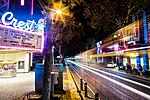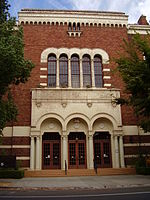California Almond Growers Exchange (CAGE), is historical building in Sacramento, California, built in 1915. The first successful almonds farmer owned cooperative was the California Almond Growers Exchange founded in 1910. The California Almond Growers Exchange working as group improved almond production and marketing. The Exchange help developed machines processing almonds, reducing cost and time to market. California Almond Growers Exchange built a new mechanical cracker for shelling almonds. California Almond Growers Exchange building is California Historical Landmark No. 967, registered on October 1, 1985. The California Almond Growers Exchange building is at 1809 C Street in Sacramento. The California Almond Growers Exchange became the Blue Diamond Growers in 1980, the cooperative is privately held. Before the California Almond Growers Exchange the Almond marker was chaotic and sometiome unprofitable. Pooling together helped all growers. The cooperative was idea of J. P. Dargitz, an almond grower from Acampo. He founded the California Almond Growers Exchange on May 6, 1910, as statewide group. Nine local cooperatives, representing 60 percent of almond production going to market, join to make the California Almond Growers Exchange. One of California Almond Growers first standard products was sold in 1912, Four pounds of packaged unshelled almonds called Blue Diamond Almonds, the product was sold in stores across the United States. In 1922 the California Almond Growers Exchange started a publication called The Minute Book, to keep the grower informed on the cooperative operation and activities, as sales grew in 1922. At its peak, in 1931 four thousand almond growers were part of the Exchange. The first local Almond Growers Association cooperative was in 1897, the Davisville Almond Growers Association. In 1962, the California Almond Growers Exchange built a three-story cold storage warehouse so sells would not need to be seasonal. Also in 1962, the California Almond Growers Exchange built a processing warehouse that also could refrigerated 4,000 tons of shelled almonds. In 2013 a new plant in Turlock, California was opened by Blue Diamond, in addition to the Sacramento plant.









